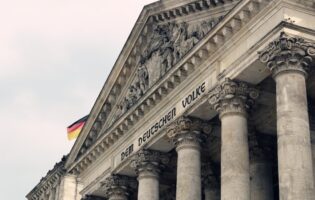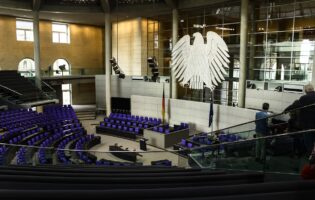
Bundesarchiv via Wikimedia Commons
The Berlin Wall

Hope M. Harrison
The George Washington University
Hope M. Harrison is Professor of History and International Affairs at The George Washington University. She is the author of 2 books about the Berlin Wall: After the Berlin Wall: Memory and the Making of the New Germany, 1989 to the Present (Cambridge University Press, 2019) and Driving the Soviet up the Wall: Soviet-East German Relations, 1953-1961 (Princeton University Press, 2003).
Sixty Years Since its Construction
Sixty years ago on August 13, East German leader Walter Ulbricht tried to save his regime by closing off the escape route to West Berlin. Since the founding of the German Democratic Republic (GDR) in 1949, more than 3 million East Germans had fled to the West. Ulbricht aimed to stop this exodus while claiming that the “anti-fascist defensive barrier” was actually to keep out West Germans and more generally the West and NATO.
The Berlin Wall became the iconic symbol of the Cold War and communist repression. Ultimately, Ulbricht’s effort to use the Wall to protect the communist regime failed, but that failure took 28 years and caused great suffering in the meantime. The impact of life behind the Wall is still felt on individuals’ lives and is reflected in voting patterns.
In the 28 years the Wall stood, hundreds of thousands of people found ways to leave the GDR, whether by escaping, being ransomed to the West, or receiving official permission to leave. In the Wall years, at least 140 people lost their lives at that border. Hundreds more were killed at East Germany’s other borders, especially along the East-West German border but also at the Baltic Sea and the borders with Poland and Czechoslovakia. The GDR levied 77,000 prison sentences on would-be escapees. Millions of East Germans felt the effects of the closed border in one way or another.
Some East Germans escaped by making it across the heavily fortified border—whether by running across it on foot, tunneling under it, flying over it, or swimming or boating across. They also escaped by traveling to other socialist countries and then going on from there to the West. This phenomenon of escaping from a communist regime continues to this day further east. North Koreans have been escaping in similar ways for decades, albeit in fewer numbers—running across the DMZ, escaping through tunnels, landing boats along the South Korean coast, or making it out to China.
The Berlin Wall became the iconic symbol of the Cold War and communist repression. Ultimately, Ulbricht’s effort to use the Wall to protect the communist regime failed, but that failure took 28 years and caused great suffering in the meantime.
The Wall impacted the lives of both the East Germans who left and those who stayed. Brigitta Heinrich lived in an East German village, Klein-Glienicke, which jutted into West Berlin and found itself surrounded by the Wall in August 1961. It became a “special security zone” with strict limitations on who could enter. With the border closed, barbed wire and concrete posts blocked off her backyard from the canal she loved to swim in and from which she and her father took boat tours around the rivers and lakes in the area.
Heinrich was studying to be a teacher when the Wall went up. After her studies, she found a job as a teacher in Klein-Glienicke and continued to live there for many years. But she increasingly felt anxiety and claustrophobia, suffering from what honest East German doctors secretly called “Wall disease,” Mauerkrankheit, brought on by the feeling of being walled in. This was particularly accentuated in the small exclave of Klein-Glienicke which was surrounded by two walls on three sides to “protect” it from West Berlin and by other security installations on the fourth side toward the water. The narrowest part of Klein-Gleinicke was only 20 yards or one-fifth the length of a football field. While in East Berlin one could theoretically go for days or weeks without ever seeing the Wall, that was impossible in Klein-Glienicke.
Heinrich finally moved across the canal to Babelsberg in 1980 when she couldn’t take having the Wall so present in her life all day, every day. Since the fall of the Wall, she has continued to suffer PTSD and needs much open space. She will join German President Frank-Walter Steinmeier in speaking at the official commemoration on August 13, as will Renate Werwigk-Schneider who also suffered because of the Wall.
Werwigk-Schneider had nearly finished her medical degree in East Berlin at Humboldt University when the border was closed. Two years later, she and her parents tried to escape via a tunnel under the Berlin Wall but were caught and imprisoned. After her release, she tried again in 1967, this time by traveling to Bulgaria to escape into Turkey. But she was caught, sent back to East Germany, and imprisoned again. In 1968, she was ransomed to West Germany as were more than 33,000 others in the 28 years the Wall stood.
Just as President Steinmeier, Chancellor Merkel, and other German leaders used the 30th anniversary of the fall of the Wall in 2019 and the 30th anniversary of German unification in 2020 to call for more East-West dialogue to bring down lingering or new “walls in the mind,” so they have continued these appeals in this 60th anniversary year of the erection of the Berlin Wall.
Since the mid-late 2000s, German public memory of the Wall has joined the Holocaust to become a fundamental part of collective memory, with politicians marking the anniversaries of its rise and fall of the Wall on August 13 and November 9. On round anniversaries, the ceremony is bigger than usual and includes the president or chancellor giving the main address, usually televised live, as it will be this year. The ceremony takes place at the national Berlin Wall Memorial on Bernauer Strasse, a street that was divided by the Wall and which featured many successful and unsuccessful escapes. It was here that Werwigk-Schneider’s failed escape via tunnel occurred. President Steinmeier (himself from the West) will give the main address at the official commemoration. Chancellor Angela Merkel is on vacation but has spoken numerous times over the years about her own memories of the Wall and how it impacted her life and those of others in East Germany.
The legacy of the Wall lives on not only in individuals such as Brigitta Heinrich who continue to suffer its effects but also in election outcomes, an important point considering the impending national elections in late September. The far-right, anti-immigrant, anti-Muslim Alternative für Deutschland party, the AfD, is much stronger in the East than the West, gaining up to ¼ of the vote in state elections there and polling now in the East at around 21 percent compared to 7 percent in the West. The Left Party is also stronger in the East where it currently polls around 13 percent compared to 4 percent in the West. Many people in the East vote for the AfD and the Left to register their frustration that their wage levels and representation in the highest levels of German politics (excepting Chancellor Merkel), economics, the media, and culture remain lower than those from the West.
Just as President Steinmeier, Chancellor Merkel, and other German leaders used the 30th anniversary of the fall of the Wall in 2019 and the 30th anniversary of German unification in 2020 to call for more East-West dialogue to bring down lingering or new “walls in the mind,” so they have continued these appeals in this 60th anniversary year of the erection of the Berlin Wall. They have also emphasized the importance of respecting not only the ways East Germans suffered while the lethal Berlin Wall was in place but also the challenges some of them have faced in united Germany.
To this day, millions of former and current Eastern Germans continue to endure lingering effects of the Berlin Wall. Even some of the former border soldiers still suffer from PTSD, something that may prove relevant to American patrol agents guarding the border with Mexico. Many countries around the world would do well to study the long-term impact of the Berlin Wall, even decades after its fall.









